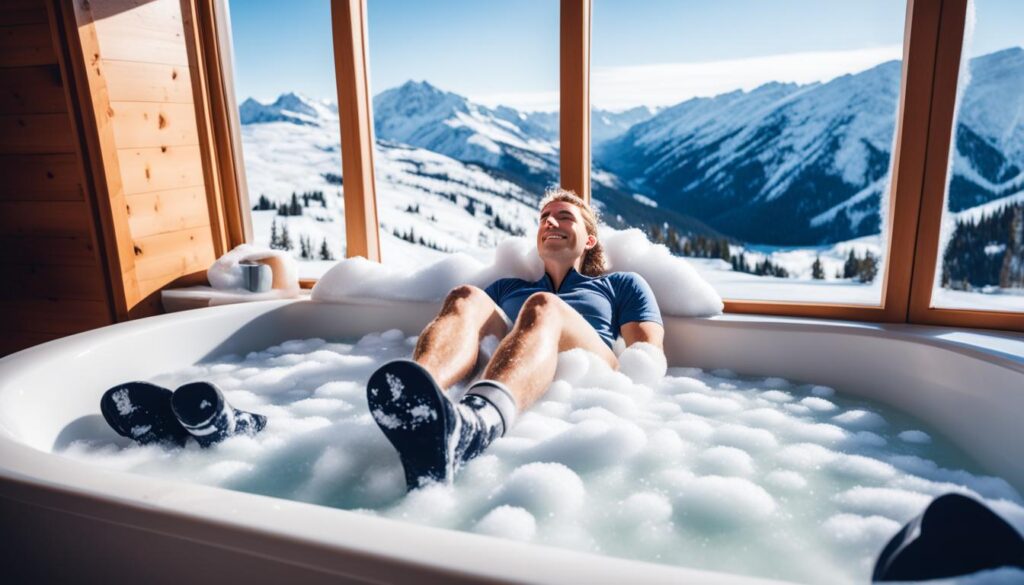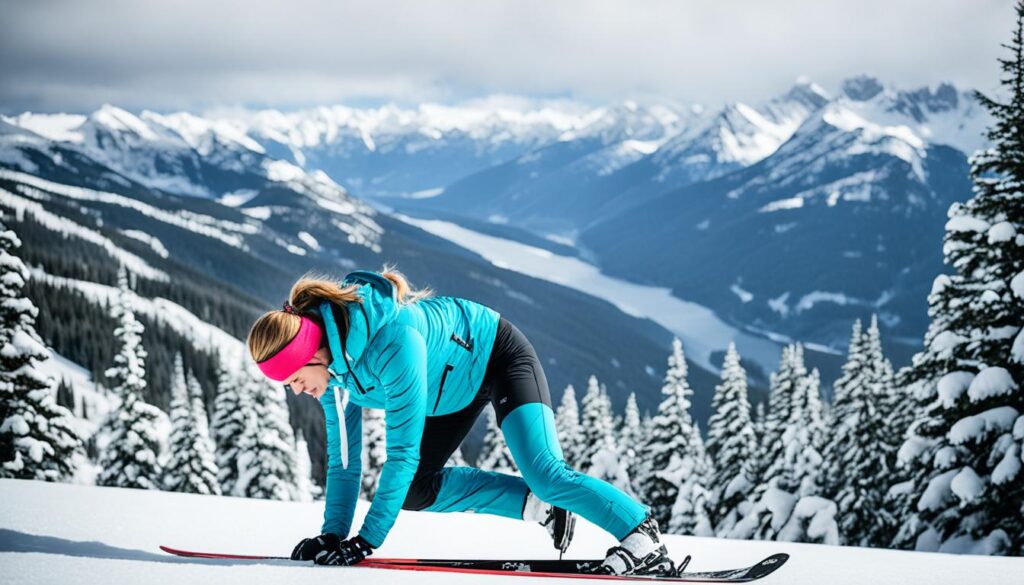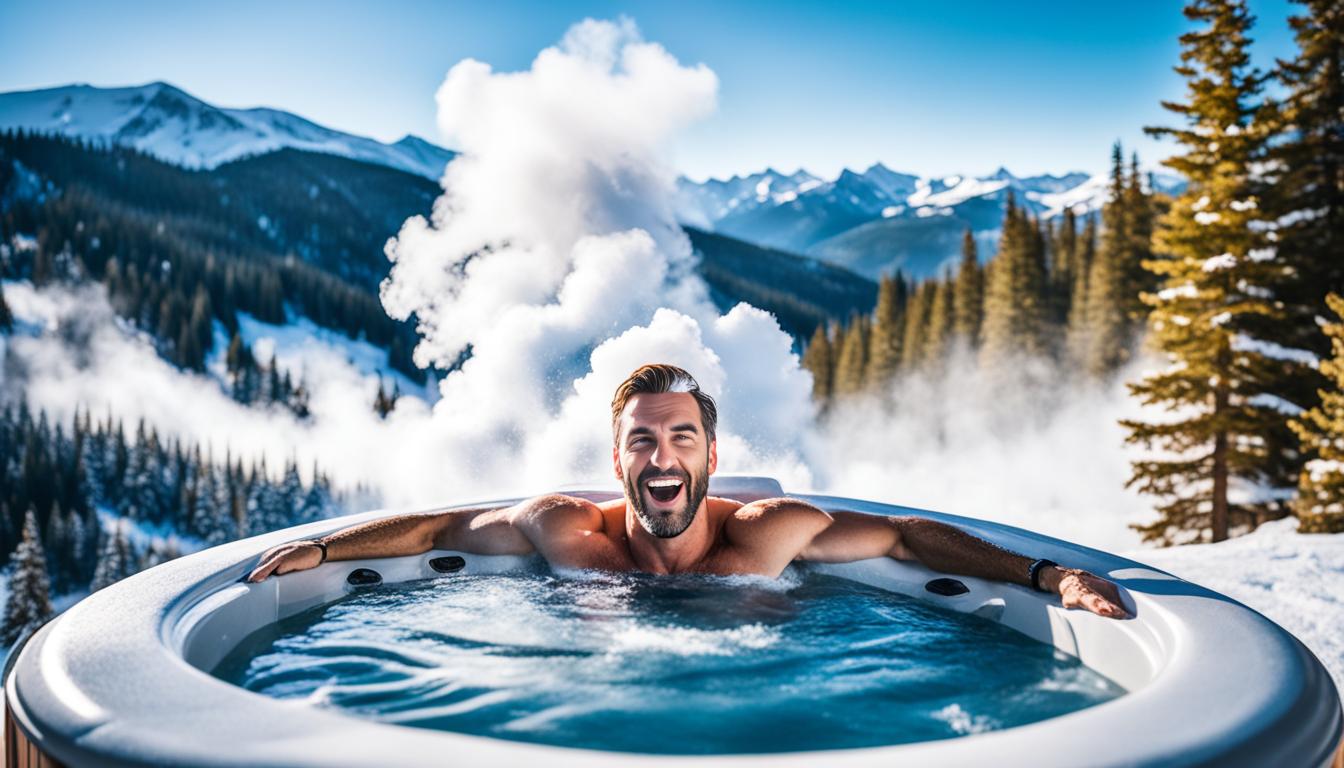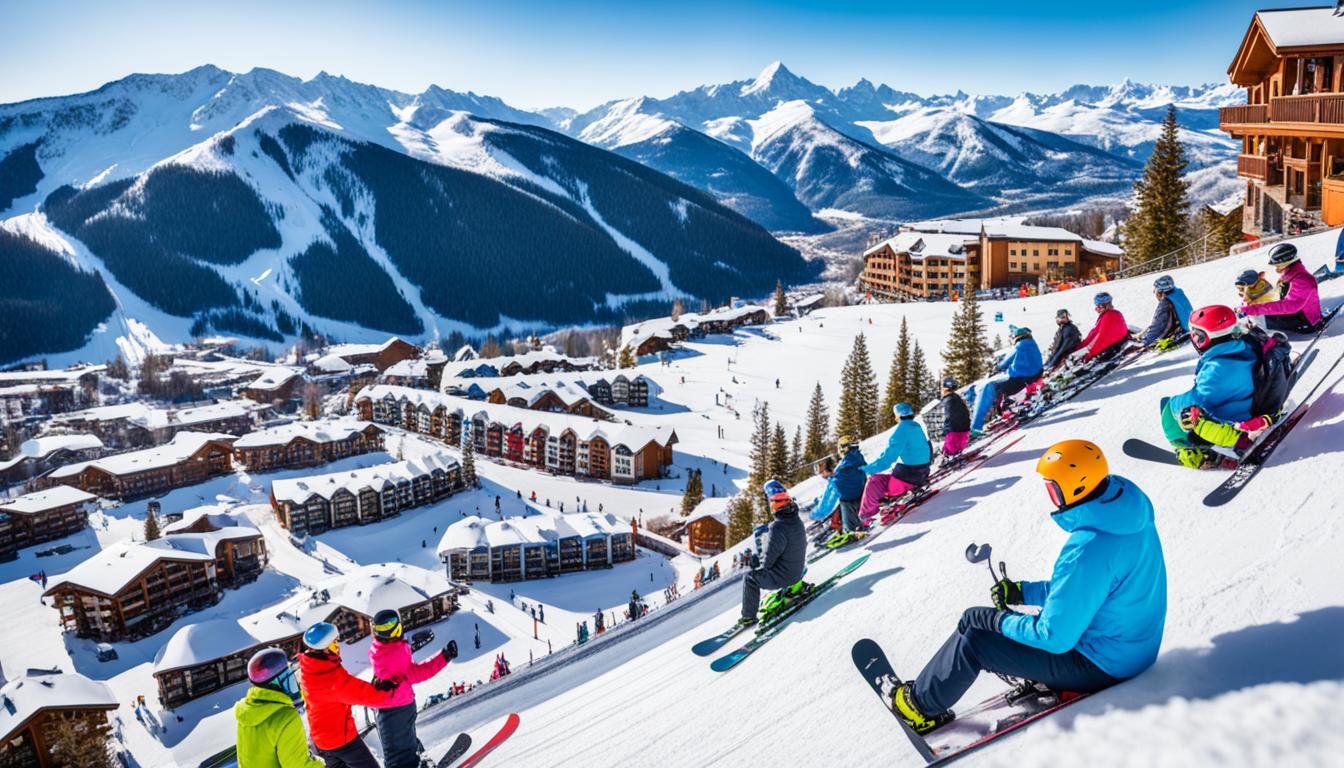After skiing, your muscles might feel sore and stiff. But, there are ways to ease this discomfort and help your body recover. From foam rolling to Epsom salt baths, these tips will boost your post-skiing renewal. They aim to make you feel better and recover quicker.
Key Takeaways:
- Incorporating foam rolling and soft tissue work can help with muscle recovery after skiing.
- Taking Epsom salt baths can promote muscle soothing and overall post-skiing wellness.
- Heat and cold therapy can provide relief and aid in faster muscle recovery.
- Stretching is crucial for muscle flexibility and preventing pain.
- Hydration and nutrition play vital roles in the recovery process.
Adding recovery tips to your after-ski routine could really help. Use foam rolling, take Epsom salt baths, and use heat or cold packs. Also, don’t forget stretching, drinking water, eating right, and getting enough rest. These steps will calm your muscles, keep you safe, and refuel your body. Adjust these strategies to your liking and conquer the slopes with more joy.
Foam Rolling and Soft Tissue Work for Muscle Recovery
After skiing all day, taking care of your muscles is a must. Foam rolling and soft tissue work are key for muscle repair. They also help reduce soreness. These steps speed up your recovery, getting you back to skiing faster.
Foam rolling uses tools like a foam roller to work on tight muscles. This is great for muscles like the outer hips and quads. These areas often get overworked from skiing. Foam rolling helps make muscles less tight, boosts blood flow, and makes you move better.
Soft tissue work is about using balls to target deep muscle knots. This method lets you focus on certain muscle points. It helps to release tension, boost circulation, and speed up healing.
Focus on the muscles that feel tense or sore when rolling or using soft tissue work. Spend a bit of time on each muscle, not rushing it. Make sure to press firmly but not too hard. Also, relax and breathe deeply to make it work better.
Don’t overlook foam rolling and soft tissue work in your recovery plan. They help your muscles heal and also keep you safe from injuries. Strong, flexible muscles lower the chances of getting hurt.
It’s time to take care of your muscles with some foam rolling or self-massage. Your body will feel better, and you’ll hit the slopes again soon!
Next, let’s talk about Epsom salt baths. They’re great for soothing muscle pain. Plus, they add a lot to your post-skiing wellbeing. Find out why they’re a go-to for many skiers’ recovery plans.
Epsom Salt Baths for Muscle Soothing
After skiing, an Epsom salt bath is a great way to relax and help your muscles feel better. Epsom salt, made of magnesium sulfate, is good for muscle recovery. It dissolves in warm water. When you soak in this bath, it helps you recover from skiing and feel refreshed.
The salt’s magnesium and sulfate reduce swelling and muscle pain. This is a natural way to feel better after a tough day of skiing. They also help pull toxins out of your body, making you feel refreshed and renewed.
Using Epsom salt baths after skiing can help your muscles get better, lower swelling, and improve your overall wellness. The warm water and salt’s calming effects help your body relax. This is perfect after an exciting day on the snow.

Enjoying an Epsom salt bath is a wonderful treat for snow sport lovers. It will make you feel calm and refreshed, getting you ready for more skiing.
“I love ending my ski day with a relaxing Epsom salt bath. It’s such a holistic ski recovery method, soothing my muscles and helping me unwind. I always feel rejuvenated and ready for another day on the slopes!” – Hannah, avid skier
How to Take an Epsom Salt Bath:
- Fill your bathtub with warm water.
- Add two cups of Epsom salt to the water.
- Stir the water to ensure the salt fully dissolves.
- Get into the bath and soak for at least 20 minutes.
- Relax, close your eyes, and enjoy the soothing experience.
| Benefits of Epsom Salt Baths for Ski Recovery: |
|---|
| Reduces inflammation |
| Relieves muscle pain |
| Promotes muscle recovery |
| Reduces swelling |
| Enhances post-skiing wellness |
Heat and Cold Therapy for Muscle Relief
When recovering from skiing, using heat and cold can help your muscles feel better. It’s about using both heat and cold wisely to calm your muscles and help them heal.
Putting ice packs on sore muscles is a great first step for relief. The cold reduces inflammation and numbs the pain, giving fast relief. Remember to wrap the ice pack in a towel to avoid skin damage. This is most helpful in the first 24-72 hours after skiing, when swelling is high.
Next, bring in the heat therapy. It boosts blood flow, relaxes muscles, and fixes small injuries from skiing. Try these heat therapy methods:
- Warm towels: Put warm towels on your sore muscles to let the heat go deep. To do this, soak towels in warm water, squeeze them out, and place them on the muscle.
- Heated zero gravity chair: For advanced recovery, a heated zero gravity chair is perfect. It supports you, warms your muscles, and takes pressure off your lower back and pelvis. This helps with blood flow and relaxes deeply.
Using both heat and cold in your recovery can speed up feeling better and make your healing journey smoother. Start with cold to limit swelling, then use heat to improve blood flow and healing.
Benefits of Heat and Cold Therapy
| Heat Therapy | Cold Therapy |
|---|---|
| Increases blood flow to muscles | Reduces inflammation |
| Promotes relaxation | Numbs the area for immediate pain relief |
| Aids in healing micro-injuries | Prevents excessive swelling |
| Enhances muscle recovery | Controls pain and discomfort |
Stretching for Muscle Flexibility and Pain Prevention
It’s key to stretch after skiing to keep your muscles flexible and prevent pain and injury. When you ski, your calves, thighs, knees, and hips work hard. Doing stretches before and after skiing can lessen soreness, cut down on stiffness, and lower injury risks.
Some great stretches can target different muscle groups and help keep you flexible:
- Deep lunges: Step forward with one leg and lower your body. Keep your back straight. Hold this for 20-30 seconds. Then, change legs and repeat.
- Step stretches: Stand on a step with your heels off the edge. Lower your heels till you feel a calf stretch. Hold for 20-30 seconds, then go back up.
- Rolling over stretches: Lie on your back with bent knees. Roll your knees slowly to one side, keeping your shoulders down. Hold for 20-30 seconds. Do the same on the other side.
Through regular stretching after skiing, you boost muscle flexibility and motion range. This also helps cut down on ski injury chances. Always stretch gently, just to where it feels good. Don’t push too hard to avoid hurting yourself.

Stretching before and after skiing is crucial for maintaining muscle flexibility and preventing pain and injuries. Incorporate deep lunges, step stretches, and rolling over stretches into your post-skiing routine for effective muscle recovery and injury prevention.
Hydration and Nutrition for Recovery
Recovering after skiing means thinking about water and what you eat. Skiing makes you sweat a lot, leading to dehydration. So, drink water before, during, and after you ski to stay healthy and help your body recover.
Eating well also helps your muscles and joints heal. After skiing, enjoy a meal with foods that fight inflammation. Think about adding green veggies, fish, nuts, olive oil, and berries. These foods are filled with things your body needs to feel better.
Foods to Include in Your Post-Skiing Meal:
- Fatty fish: Salmon, trout, and tuna are packed with good fats that fight inflammation and keep your joints healthy.
- Green leafy vegetables: Spinach, kale, and Swiss chard have a lot of vitamins and antioxidants. These help with your overall recovery.
- Nuts: Almonds, walnuts, and pistachios are full of healthy fats, protein, and fiber. They help repair muscles and reduce inflammation.
- Olive oil: Extra virgin olive oil has properties that fight inflammation, helping your muscles and joints recover.
- Berries: Blueberries, strawberries, and raspberries are full of antioxidants. These fight inflammation after exercise, aiding in your recovery.
Proper hydration and eating right help your body bounce back after skiing. These simple steps will help your muscles feel better. Then, you can enjoy skiing again, feeling fresh and ready for more fun.
Testimonials:
“I started drinking enough water and eating the right foods after skiing. My muscles recover much better now, and I’m full of energy to ski more!” – Amanda, avid skier
Relaxation and Rest for Full Recovery
After skiing, make sure to relax and rest. This helps your body recover and get ready for more snow sports. Taking time to chill and rejuvenate is key for feeling good after skiing.
A zero gravity chair can boost your relaxation and recovery. It offers comfy seating and health perks. The chair’s design lifts your legs, taking pressure off your lower back and helping blood flow. This makes your body heal faster.
This chair isn’t just good for your body; it helps you relax deeply too. The way it holds you lets you fully chill. Feeling like you’re floating in the chair calms your muscles and your mind.
Relaxing and resting is crucial for your health. Adding a zero gravity chair to your after-ski routine shows you care about your well-being. It preps you for another awesome day on the slopes.
Conclusion
It’s key to add wellness tips into your post-skiing time. This helps your muscles heal and boosts your health. Try using foam rolling, Epsom salt baths, and hot and cold treatments. Also, don’t forget about stretching, drinking water, eating right, relaxing, and getting plenty of sleep. These steps can all help you recover faster after skiing.
Listening to how your body feels is crucial. You should tweak these tips to make them work best for you. Every person’s body heals in its own way. So, making these recovery techniques your own is smart.
By using these skiing recovery hints, and focusing on wellness, you’ll master skiing. Always look after your body, from preparing before skiing to recovering after. This can boost your fun and success in the thrilling world of skiing.
FAQ
What are some effective strategies for ski recovery and after-ski care?
To recover from skiing, try foam rolling and soft tissue work. Epsom salt baths are also great. Use heat and cold therapy. Stretching helps too.
Don’t forget to drink lots of water and eat well. And, most importantly, make sure to get plenty of rest and relaxation.
How does foam rolling and soft tissue work help with muscle recovery after skiing?
Foam rolling uses a foam roller to massage muscles. Soft tissue work means using massage sticks. Both methods aim to help muscles recover.
They stretch tight tissue and boost blood flow. This speeds up muscle healing.
What are the benefits of taking an Epsom salt bath after skiing?
An Epsom salt bath can calm achy muscles. It has magnesium sulfate which fights swelling and eases pain.
It also helps your muscles recover. Plus, it feels really nice after a long day of skiing.
How does heat and cold therapy aid in muscle relief and recovery after skiing?
Cold therapy with ice packs eases muscle pain fast. This step should be followed by heat therapy.
Heating muscles helps them relax and heal. Warm towels or zero gravity chairs offer extra relaxation.
Why is stretching important for muscle flexibility and pain prevention after skiing?
Stretching is key for prevent soreness and injury post-skiing. It makes muscles flexible and less likely to get hurt.
Try moves like deep lunges and step stretches. They target different areas, keeping you limber.
How does hydration and nutrition contribute to the recovery process after skiing?
After skiing, you need lots of water to replace lost fluids. Eating right with foods like vegetables and fish aids recovery.
Proper diet and hydration fight off fatigue. They help joints and muscles recover faster.
Why is relaxation and rest essential for full recovery after skiing?
Rest is crucial after skiing. Zero gravity chairs are great for this. They reduce pressure and boost relaxation.
This preparation is vital for your next skiing adventure.




